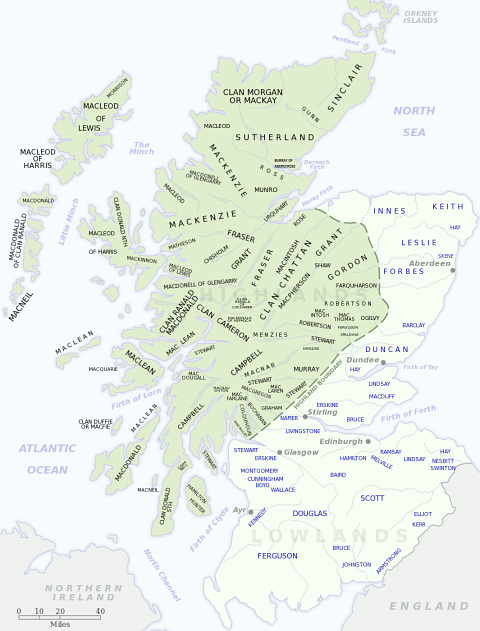
Motto: I hope in God
Historic Seat: Dunderave Castle
District: Argyll
Associated Surnames: Ayson, MacColl, MacCracken, MacHarry, MacHendry, MacHenry, MacKendrick, MacKnight, MacNaghten, MacNair, MacNatt, MacNitt, MacNorton, MacNutt, Portland, Vicars, Vickers, Weir
Associated Tartans:
Early MacNaughton Genealogy and History:
(Excerpt from "The Scottish Clans and Their Tartans", James Grant, 1906)
This clan takes its name from Nectan, or Nauchton. Several Pictish kings were so called; but the best known is that King who founded Abernethy, or, as the Highlanders name it to this day, Abair Neachtain. The Iona Club manuscript1, in deducing their pedigree, begins with Moris, or Maurice, son of Malcolm, and traces them up to Ferchar Fada, a petty prince of the Iro-Scots in Argyll-shire, and then goes father back to Lorne (or Loarn), a reputed son of Erc, and one of the leaders of the little Irish colony in 506. The lands and possession of the clan were certainly within Lorne, on the shore of Lochow.
Douglas, in his "Baronage of Scotland," records an ancient grant by charter from Alexander III (1249-85) to Gilchrist MacNaughton of the custody of the Castle and Island of Fraoch, in Lochow. MacNaughton's tenure was that he should entertain the King whenever he passed that way.
The MacNaughtons fought against Bruce in 1306 at the battle of Dalree,2 where their leader pointed out to the Lord of Lorne the King's deeds of valour in covering the retreat.
On the forfeiture of John, grandson of Alexander of the Isles, John MacNaughton of that Ilk got a grant of his lands by a charter from David II about 1344 (Rob, Index, p. 48).
In the reign of Robert III Sir Colin Campbell of Lochow granted a Charter of Confirmation to "Maurice MacNaughton of sindrie lands in Over Lochow, with ane taillie, which are not to be copied."
In 1426 one of the clan, Donald MacNaughton, Bishop-elect of Dunkeld, died on his way to Rome when proceeding there for confirmation.
Sir Alexander MacNaughton of that Ilk was slain with King James at Flodden3 in 1513.
Maurice MacNaughton of Dunderaw appears in the Roll of the Chiefs in the Parliament of 1587.
In 1627 Alexander MacNaughton of that Ilk, levied, by order of Charles I, one of the finest bands of Highland archers that Scotland ever had, to serve in the war against France, for which they sailed with MacKinnon's men, with many pipers and harpers. Alexander MacNaughton was deemed, says Buchanan of Anchmar, one of the bravest and most accomplished men of his time. He was a loyal servant to Charles I and II, and had the honour of knighthood conferred on him, with a pension by the latter. The latter part of his life he spent at Court, and died in London.
In 1707 the eldest son of the chief, Captain MacNaughton of the Scots Foot Guards, was killed in battle in Spain.
Among a list of arms and goods in the Castle of Kilbhurn in 1689 are recorded "two chists undir bagage of Lady M'Nauchton's, and anoyr wit a lock yt Andrew Chystie hes."4 It is doubtful whether the lady referred to was the wife of Malcolm MacNaughton of that Ilk, or of his son Alexander, also of that Ilk. The former married Mary, daughter of Donald Murray, Provost of Inverary, and the latter married a daughter of Sir Colin Campbell of Ardkinglass.
A copy of a complimentary letter, written by James VII to MacNaughton of that Ilk on the 30th November 1689, is inserted in the "Leven and Melville Papers," prepared by the Hon. Leslie Melville for the Bannatyne Club.
A branch of the MacNaughtons settled in the county of Antrim, where they amassed a good estate, with a castle called Benuardin.
In 1878 a meeting of the Clan MacNaughton was held at the Literary Institute, Edinburgh, when a committee reported that they had made an investigation regarding the chieftainship, and had unanimously resolved that Sir Francis Edmund MacNaughton, Bart.,5 of Dunderove, Antrim, lineal descendant of the ancient line, should be held the chief. His ancestor was Ian Dhu, third son of Sir John MacNaught of that Ilk, and grandson of Sir Alexander, who fell at Flodden. He went to Ireland as secretary to his kinsman, Earl of Antrim, and settled there.
The above-named Sir Francis Edmund MacNaughton's brother, Edward, was in 1887, created a Lord of Appeal as Lord MacNaughton.
(End excerpt)
Next page: Clan MacNeil
Footnotes:
1 Iona Club manuscript: Collectanea de Rebus Albanicis, a book printed in 1847 for members of a Scottish society, relating to the history of the Highlands and islands of Scotland. Free eBook available at Google Books.
2 The Battle of Dalrigh: The Battle of Dalrigh, also known as the Battle of Strathfillan, was fought on 11 August 1306 between the army of King Robert I of Scotland against the Clan MacDougall of Argyll who were allies of Clan Comyn and the English. It took place at the hamlet of Dalrigh near Tyndrum in Perthshire, Scotland. Read more about the Battle of Dalrigh at Wikipedia.
3 The Battle of Flodden (1513): The Battle of Flodden Field was fought on 9 September 1513, in Northumberland England between an army of Scots under King James IV and an English army commanded by the Earl of Surrey. Read more about the Battle of Flodden at Wikipedia.
4 two chists undir bagage of Lady M'Nauchton's, and anoyr wit a lock yt Andrew Chystie hes: two chests under baggage of Lady MacNaughton's, and another with a lock that Andrew Chystie has
5 Bart.: Baronet

Distribution of Scottish clans and families
View larger map at Wikimedia Commons

Browse the Clan MacNaughton Tartan Collection with clothing, home decor, accessories, electronics cases, and more.

Browse the Argyll District Tartan Collection with home decor, personal accessories, crafting, paper products, and more.

Clan MacNaughton Postcard: Digitally cleaned and enhanced vintage illustration with tartan border.